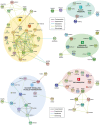The impact of genome-wide association studies on the pathophysiology and therapy of cardiovascular disease
- PMID: 27189168
- PMCID: PMC4931285
- DOI: 10.15252/emmm.201506174
The impact of genome-wide association studies on the pathophysiology and therapy of cardiovascular disease
Abstract
Cardiovascular diseases are leading causes for death worldwide. Genetic disposition jointly with traditional risk factors precipitates their manifestation. Whereas the implications of a positive family history for individual risk have been known for a long time, only in the past few years have genome-wide association studies (GWAS) shed light on the underlying genetic variations. Here, we review these studies designed to increase our understanding of the pathophysiology of cardiovascular diseases, particularly coronary artery disease and myocardial infarction. We focus on the newly established pathways to exemplify the translation from the identification of risk-related genetic variants to new preventive and therapeutic strategies for cardiovascular disease.
Keywords: atherosclerosis; coronary artery disease; genome‐wide association studies; myocardial infarction.
© 2016 The Authors. Published under the terms of the CC BY 4.0 license.
Figures




References
-
- Abifadel M, Varret M, Rabès JP, Allard D, Ouguerram K, Devillers M, Cruaud C, Benjannet S, Wickham L, Erlich D et al (2003) Mutations in PCSK9 cause autosomal dominant hypercholesterolemia. Nat Genet 34: 154–156 - PubMed
-
- Ballantyne CM, Neutel J, Cropp A, Duggan W, Wang EQ, Plowchalk D, Sweeney K, Kaila N, Vincent J, Bays H (2015) Results of bococizumab, a monoclonal antibody against proprotein convertase subtilisin/kexin type 9, from a randomized, placebo‐controlled, dose‐ranging study in statin‐treated subjects with hypercholesterolemia. Am J Cardiol 115: 1212–1221 - PubMed
-
- Barrett JC, Dunham I, Birney E (2015) Using human genetics to make new medicines. Nat Rev Genet 16: 561–562 - PubMed
Publication types
MeSH terms
LinkOut - more resources
Full Text Sources
Other Literature Sources
Medical
Miscellaneous

